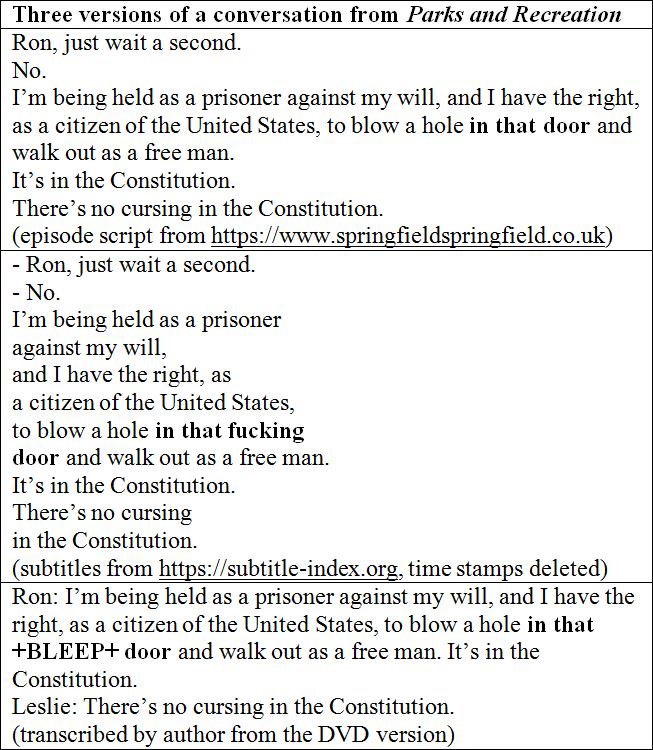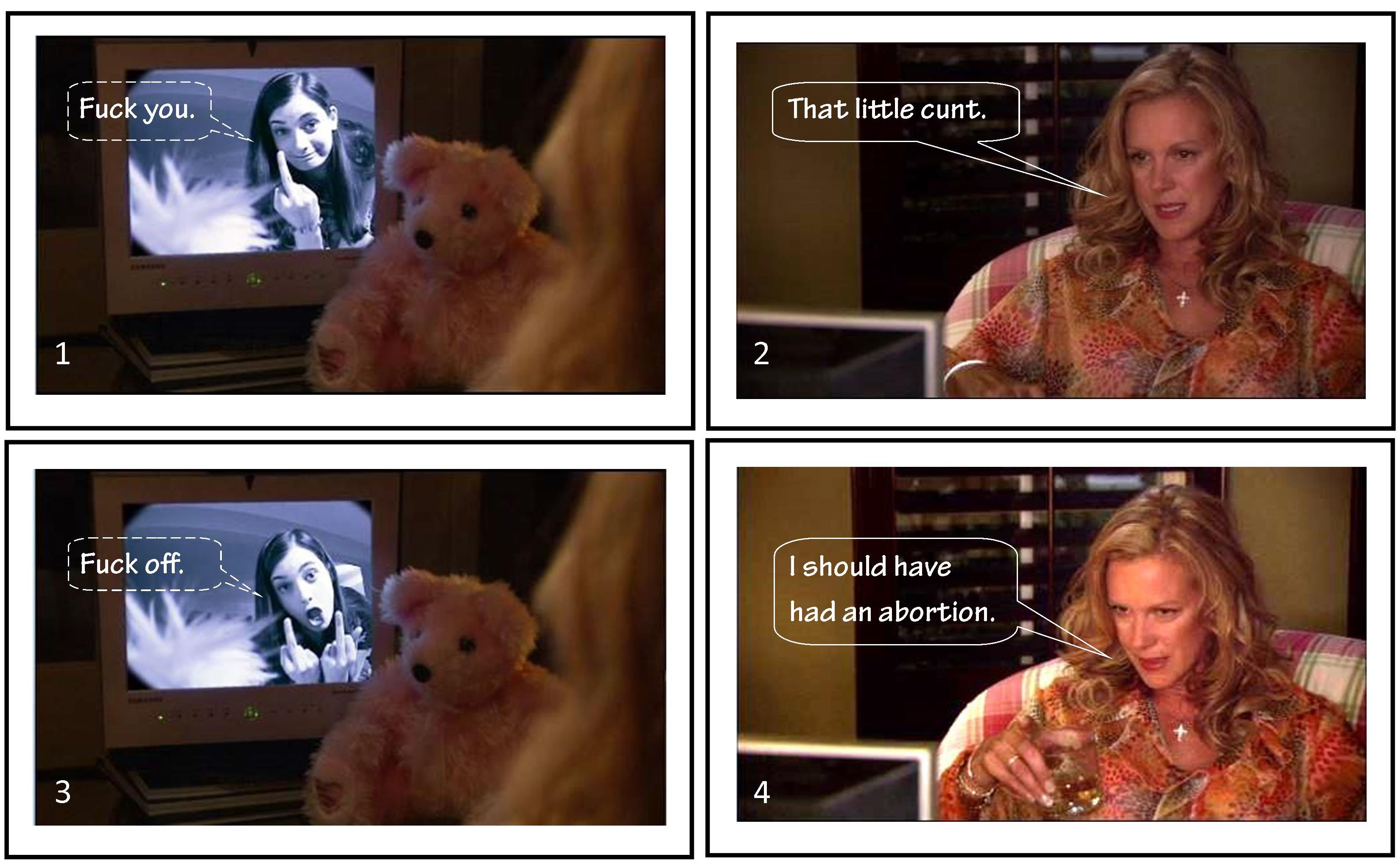Contemporary US TV series are now consumed worldwide, including by many viewers who do not speak English as a first language. When consumed in the original version, television dialogue can be a key way in which learners encounter spoken English language, and may constitute an influential model (Mittmann 2006: 575; Bleichenbacher 2008: 2). In the context of swear/taboo words this is even more significant since such words are unlikely to be taught in the classroom or to occur in textbooks, while learners tend to be fascinated by them but have limited knowledge of their use (Dewaele 2004: 205). In fact, such speakers ‘differ significantly in their understanding of the meaning, perception of offensiveness and self-reported frequencies of use of most emotion-laden words from L1 users of English’ (Dewaele 2016: 122). Further, the use of swear/taboo words in TV series generates significant discussion, especially in the US, where public decency groups such as the Parents Television Council contribute to censoring American television culture (McCabe & Akass 2007: 64-65). There are hence multiple reasons for the study of swear/taboo words in US TV series.
One interesting phenomenon that can be observed across many US TV series is the presence of metalinguistic comments in characters’ speech about their own or others’ use of swear/taboo words, as in the following examples:
‘Don’t say cocks.’ (Arrested Development)
‘Don’t say crap. Don’t use swear words.’ (Baby Daddy)
‘Don’t say Jesus.’ (The Big C)
‘I would’ve told him to go fuck himself. But I don’t talk like that.’ (Big Little Lies)
‘And you can clean up your fucking mouth.’ (Bloodline)
‘You kiss your mother with that mouth?’ (Brooklyn 99)
‘Kenny, you cannot talk to my son that way!’ (Eastbound and Down)
‘… using some language that a bald eagle never uses.’ (Eastbound and Down)
‘Emily, this language, where is it coming from?’ (Gilmore Girls: A Year in the Life)
‘Please don’t talk like that in there.’ (Homeland)
‘I’ll spare the court the language that Annalise used.’ (How to Get away with Murder)
‘Why are you cursing?’ (Mad Men)
‘Hey! Language.’ (Orange is the New Black)
‘You watch your language.’ (Orange is the New Black)
‘No need to curse.’ (Parks and Recreation)
‘There’s no cursing in the Constitution.’ (Parks and Recreation)
‘You gotta stop cussing, man.’ (Saving Grace)
‘… mind if I drop by to interrupt your cussing spell.’ (True Blood)
‘Don’t you dare take the lord’s name in vain.’ (True Blood)
‘Can I swear in front of you now?’ (Veep)
‘Okay, well, we don’t need that kind of language, but thank you.’ (Veep)
The vast majority of such comments are negative, with characters often using commands or requests not to use such language or querying why such language is used. In several cases, the comments reflect and construct language ideologies and folk attitudes about swear/taboo words. While these metalinguistic comments clearly have various narrative functions, what they all do is make the swear/taboo words noticeable or psychologically salient, keeping them in cultural awareness. Such metadiscourse jointly brings this set of words into being as a socially recognisable category. (Read more here).
In relation to corpus analysis, it is important to note that there can be differences in how swear/taboo forms are present in versions of a TV series (scripts, subtitles, DVD), as seen in Table 1:

Table 1 Three versions of the same conversation (Parks and Recreation, season 7, episode 4, “Leslie & Ron”)
In addition, the corpus does not capture gestures that may replace or accompany swear/taboo words (Figure 1), as it does not include information on body language.

Figure 1 Example from Weeds (season 1, episode 1, “You can’t miss the bear”)
On this site I present an interactive visualization from an initial study of the frequency and distribution of selected swear/taboo word forms in SydTV (Bednarek under review; see also Bednarek 2019):
Alternatively, you can use this online interface to undertake your own analyses of swear/taboo word forms in SydTV.
References
Bednarek, M. under review. Swear/taboo words in US television series: production, use, consumption
Bednarek, M. 2019. The multifunctionality of swear/taboo words in television series. In L. Mackenzie & L. Alba-Juez (eds). Emotion in Discourse. Amsterdam/Philadelphia: John Benjamins: 29-54.
Bleichenbacher, L. 2008. Multilingualism in the Movies. Hollywood Characters and their Language Choices. Tübingen: Francke.
Dewaele, J.-M. 2004. The emotional force of swearwords and taboo words in the speech of multilinguals. Journal of Multilingual and Multicultural Development 25 (2-3): 204-222.
Dewaele, J.-M. 2016. Thirty shades of offensiveness: L1 and LX English users’ understanding, perception and self-reported use of negative emotion-laden words. Journal of Pragmatics 94: 112-127.
McCabe, J. & K. Akass 2007. Sex, swearing and respectability: Courting controversy, HBO’s original programming and producing quality TV. In J. McCabe & K. Akass (eds). Quality TV. Contemporary American Television and Beyond. London/New York: I.B. Tauris, 62-76.
Mittmann, B. 2006. With a little help from Friends (and others): Lexico-pragmatic characteristics of original and dubbed film dialogue. In C. Houswitschka, G. Knappe & A. Müller (eds). Anglistentag 2005, Bamberg – Proceedings. Trier: WVT, 573-585.
